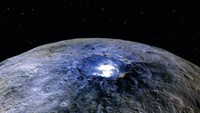Advertisement
Grab your lab coat. Let's get started
Welcome!
Welcome!
Create an account below to get 6 C&EN articles per month, receive newsletters and more - all free.
It seems this is your first time logging in online. Please enter the following information to continue.
As an ACS member you automatically get access to this site. All we need is few more details to create your reading experience.
Not you? Sign in with a different account.
Not you? Sign in with a different account.
ERROR 1
ERROR 1
ERROR 2
ERROR 2
ERROR 2
ERROR 2
ERROR 2
Password and Confirm password must match.
If you have an ACS member number, please enter it here so we can link this account to your membership. (optional)
ERROR 2
ACS values your privacy. By submitting your information, you are gaining access to C&EN and subscribing to our weekly newsletter. We use the information you provide to make your reading experience better, and we will never sell your data to third party members.
Physical Chemistry
Comets Questioned As Water Source
Space: Space science Rosetta spacecraft reports high D/H ratio from comet 67P
by Elizabeth K. Wilson
December 10, 2014

Water contained in the comet 67P/Churyumov-Gerasimenko has a deuterium/hydrogen ratio vastly unlike that on Earth, a new study reports (Science 2014; DOI: 10.1126/science.1261952). The finding implies that comets may not have seeded our nascent planet with water.
The results, obtained from the ROSINA instrument aboard the European Space Agency’s Rosetta spacecraft, which is orbiting the comet, were announced at a press conference on Dec. 9.
A more likely water source for Earth would be asteroids, experts now say. These planetary bodies would have still been laden with water billions of years ago, before being gradually dried by the sun.
“This is a nice start to the science phase of the mission,” Matt Taylor, project scientist for the Rosetta mission, said at the conference.
The idea that comets might have brought water to a cooling new Earth has a complex history. Astronomers have long known that comets hailing from the Oort cloud that lies at the farthest regions of the solar system have a D/H ratio about twice as high as the ratio found in water on Earth. And for a while, the consensus was that comets couldn’t have been our water source.
But three years ago, scientists were surprised to find Earth-like D/H ratios in the comet Hartley 2, which resides in the Kuiper belt—a region closer than Oort cloud. A picture then emerged of an Earth seeded by Kuiper belt comets.
Rosetta’s surprising new data now show that 67P, despite being a Kuiper belt comet, has a ratio that’s very high, much higher even than that of Oort cloud comets.
Michael A’Hearn, a University of Maryland emeritus astronomy professor who works on two different Rosetta instruments, says he found the result “startling,” but that it also supports his idea that comets in the Kuiper belt formed over a wide range of distances from the sun.
Kathrin Altwegg of the University of Bern, in Switzerland, principal investigator for Rosetta’s ROSINA instrument, said at the conference that this new information suggests the Kuiper belt contains a mix of comets. The addition of even a few comets like 67P with high D/H ratios would be enough to raise the average ratio of all Kuiper belt comets to higher than the ratio in Earth’s water.
A’Hearn believes the jury is still out, however, because early in the solar system’s history, comet groups may have been more segregated, and those that bombarded early Earth therefore may have been more uniform..





Join the conversation
Contact the reporter
Submit a Letter to the Editor for publication
Engage with us on Twitter